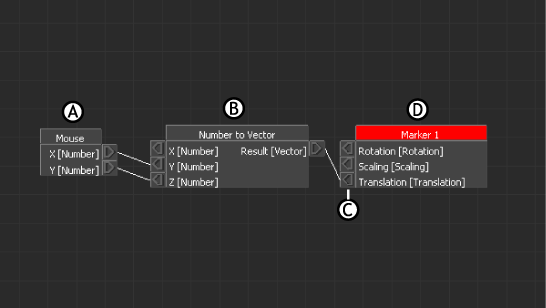When a Relations constraint is selected, the Constraint settings display the Relations pane, a grid where you construct the relation.
Relations constraints map data to models, lights, cameras, and output devices. This data can be animation, a recorded take, or live movement captured from a magnetic system, glove, mouse, joystick, and so on.
A Relations constraint is basically a connection between an input device and a model, but they can also be made between input and output devices, or models and output devices. Unlike other constraints, you construct your own Relations constraint in a grid.
When you select Relations in the Scene browser, the Constraint settings window displays the Relations pane and the Object browser appears in the Constraint settings.

Relations constraint A. Sender B. Operator C. Connector D. Receiver
A Relations constraint consists of at least two objects. One object transmits data (Sender) while the other object interprets the sent data (Receiver).
For example, the relation in maps the movement of the mouse to a marker. Between the Sender and Receiver, an Operator converts the numerical data from the mouse to a vector for use by the marker. Operators are used to perform mathematical operations, comparisons, or conversions.
The Sender object can be an input device, such as a mouse, and the Receiver object data can be a model, light, or output device. See Connecting Senders, Operators, and Receivers for information on how to connect input and output boxes.
 Except where otherwise noted, this work is licensed under a Creative Commons Attribution-NonCommercial-ShareAlike 3.0 Unported License
Except where otherwise noted, this work is licensed under a Creative Commons Attribution-NonCommercial-ShareAlike 3.0 Unported License